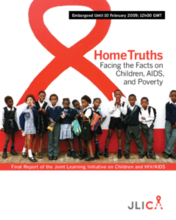A critical home truth confronted in this report is the neglect of millions of children and their families in the global response to the AIDS epidemic. Well-intentioned but misdirected efforts have drained resources that could have been invested more effectively for children and young people. Responses to date have not been sufficiently grounded in either evidence about children’s circumstances, or a clear understanding of the root causes of children’s vulnerability. This report summarizes the evidence emerging from two years of research and analysis by the Joint Learning Initiative on Children and HIV/AIDS (JLICA), an independent alliance of researchers, implementers, activists, policymakers, and people living with HIV. Its findings show that unless governments and their partners address the underlying issues of family poverty and gender inequality, large-scale AIDS programmes in severely affected countries will continue to fall far short of what is needed — and of what could be achieved.
This report considers a number of fundamental misperceptions that have undermined the global response to children affected by the epidemic, and sets out evidence on how to better respond to their needs. While families care best for children, many efforts to assist children affected by HIV and AIDS ignore the clear benefits of supporting families and communities. Families and communities currently bear approximately 90% of the financial cost of caring for infected and affected children in the areas hardest hit by AIDS. Many of these families are already living in extreme poverty, yet few receive any support from sources outside their communities.
To date, responses to children in the context of HIV and AIDS have been primarily focused on children who have lost one or both of their parents to the epidemic. This focus has created and fed a powerful myth, namely that the majority of children who have lost a parent to aids lack family and social networks and, therefore, require nonfamily or orphanage care. JLICA’s research, however, shows that some 88% of children designated as orphans actually have a surviving parent. Approximately 95% of all children directly affected by HIV and AIDS, including those who have lost parents, continue to live with their extended families.
The backdrop to much of the AIDS epidemic is extreme poverty. Unless family poverty is addressed, key long-term investments in children will be compromised. Poverty does not cause aids. But AIDS does cause and compound poverty, and impedes efforts to reduce its impact. Over 60% of children in southern Africa live in poverty. Families who are already poor when HIV strikes may be unable to compensate for further loss of income that occurs as a result of aids-related illness or death.
The report identifies failures in existing approaches to children and families affected by HIV and AIDS, and calls for fundamental shifts in policies, programmes, and funding to squarely refocus the response along four critical lines of action:
- providing support for children to and through their families;
- strengthening community support for families;
- reducing family poverty;
- delivering integrated family-centred services in health, education, and social welfare

